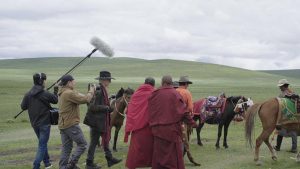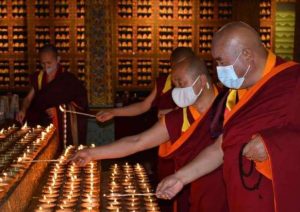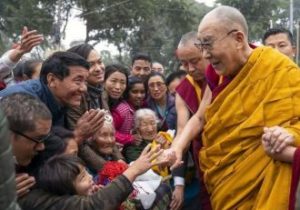
My teacher, Venerable Nyanaponika Maha Thera, has translated and retold an ancient Buddhist tale that figuratively illustrates how beings can create both the arousal and the elimination of anger. (Piyadassi 1994, 2–3)
The story reads like this:
Once there lived a demon who had a peculiar diet: he fed on the anger of others. And as his feeding ground was the human world, there was no lack of food for him.
He found it quite easy to provoke a family quarrel, or national and racial hatred. Even to stir up a war was not very difficult for him. And whenever he succeeded in causing a war, he could properly gorge himself without much further effort; because once a war starts, hate multiplies by its own momentum and affects even normally friendly people.
So the demon’s food supply became so rich that he sometimes had to restrain himself from overeating, being content with nibbling just a small piece of resentment easily found nearby.
But as often happens with successful people, he became rather overbearing and one day when feeling bored he thought:
“Shouldn’t I try it with the gods?”
On reflection he chose the Heaven of the Thirty-three Deities, ruled by Sakka, Lord of Gods. He knew that only a few of these gods had entirely eliminated the fetters of ill-will and aversion, though they were far above the kind of petty and selfish quarrels that we worldlings get into.
So by magic power he transferred himself to that heavenly realm and was lucky enough to come at a time when Sakka, the Divine King, was absent.
There was no one in the large audience hall and without much ado the demon seated himself on Sakka’s empty throne, waiting quietly for things to happen, which he hoped would bring him a good feed.
Soon, some of the gods came to the hall and first they could hardly believe their own divine eyes when they saw that ugly demon sitting on the throne, squat and grinning.
Having recovered from their shock, they started to shout and lament:
“Oh you ugly demon, how can you dare to sit on the throne of our Lord? What utter cheekiness! What a crime! You should be thrown headlong into the hell and straight into a boiling cauldron! You should be quartered alive! Begone! Begone!”
But while the gods were growing more and more angry, the demon was quite pleased because from moment to moment he grew in size, in strength, and in power.
The anger he absorbed into his system started to ooze from his body as a smoky red-glowing mist. This evil aura kept the gods at a distance and their radiance was dimmed.
Suddenly a bright glow appeared at the other end of the hall and it grew into a dazzling light from which Sakka emerged, the King of Gods.
He who had firmly entered the undeflectible Stream that leads Nibbana-wards, was unshaken by what he saw. The smoke-screen created by the gods’ anger parted when he slowly and politely approached the usurper of his throne.
‘Welcome, friend! Please remain seated. I can take another chair. May I offer you the drink of hospitality? Our Amrita is not bad this year. Or do you prefer a stronger brew, perhaps the vedic Soma?’
While Sakka spoke these friendly words, the demon rapidly shrank to a diminutive size and finally disappeared, trailing behind a whiff of malodorous smoke, which likewise soon dissolved. (Based on the Samyutta Nikaya, Sakka Samyutta, No.22)
The gist of this story dates back to times of the discourses of the Buddha. But even now, well beyond 2,500 years later, our present-day world looks as if large hordes of anger-eating demons are not only haunting it, but are also kept well-nourished by the millions slaving for them, in one way or another, all over the Earth. Fires of hate and waves of violence threaten to engulf mankind. The grass roots of society are poisoned by conflict and discord, manifesting in angry thoughts, words, and violent deeds.
Is it not time to end this self-destructive slavery of man to his impulses of hate and aggression which only serve the demoniac forces? Our story tells how these demons of hate can be exorcised through the power of gentleness and love. If this power of love can be tested and proven, at the grassroots level, in a widely spread net of personal relationships, society at large, the world at large, may not remain unaffected by it.
And further, we should reflect on the advantages of the development of mind through the practice of extending loving-kindness. For, the Buddha has expounded to us 11 advantages to be looked for from its development:
What are the eleven? The person who fully develops loving-kindness sleeps happily. He wakes happily. He experiences no evil dreams. He is beloved of men. He is beloved even of non-human beings. He is protected by the gods. He can be harmed neither by fire, poison, or a weapon. His mind is quickly composed. His complexion is serene. At the moment of his death he passes away unbewildered. If he can go no further along the path of realization, he will at least be reborn in the heavenly abode of the Brahma Devas. (Anguttara Nikaya 11.16)
So by every similar and possible way should we endeavor to quench our anger and at last be able to extend our loving-kindness toward any and every being in the world. When we are able to curb our anger and control our minds, we should extend from ourselves boundless love as far as we can imagine, throughout every direction, pervading and touching all living beings with loving-kindness. We should practice this meditation every day at regular times without any break.
As a result of such a practice, we may be able, one day, to attain the jhanas or meditative absorptions, comprising four grades that entail the control of sensuality, ill-will, and many other passions, bringing at the same time purity, serenity, and peace of mind. Once we know how to avoid the arousal of anger by eradicating its cause, we will then become capable of living a life of harmony and peace.
References
Piyadassi Maha Thera. 1994. The Elimination of Anger. Kandy: Buddhist Publication Society Bodi Leaves No. 68.
Includes a story retold by Venerable Nyanaponika based on the Samyutta Nikaya, Sakka Samyutta, No. 22.












